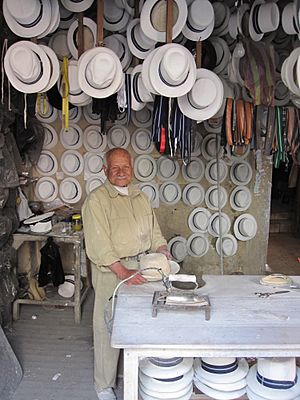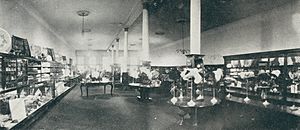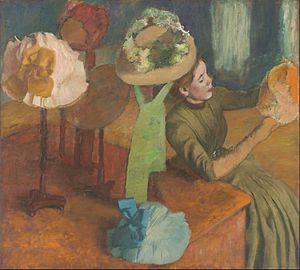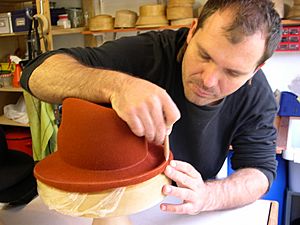Hatmaking facts for kids
Hat-making, also known as millinery, is the art of designing, making, and selling hats and other headwear. A person who does this job is called a milliner.
Even though some people think millinery is only for women's hats, milliners actually make hats for everyone – women, men, and children. In the past, milliners were often women who owned shops. They would make or buy many different clothes and hats. They sold these items in their millinery shops. Because hats and clothes go together, many milliners were also fashion designers. Famous examples include Rose Bertin, Jeanne Lanvin, and Coco Chanel.
The hat-making industry grew a lot during the 1800s. This was thanks to new factories and machines. In 1889, over 8,000 women worked in hat-making in London and Paris. By 1900, about 83,000 people, mostly women, worked in this field in New York. Even with new technology, milliners still need important skills, creativity, and craftsmanship. Many parts of making a hat cannot be done by machines even today.
Mass-produced hats, like baseball caps, have made more people wear hats. They help show team spirit and offer protection. However, these hats are not unique. A milliner designs a special, custom-made hat for each client. This makes each hat one-of-a-kind. So, a milliner usually means someone who uses traditional hand skills. They design, make, sell, or decorate hats, often for individual customers. Most of their clients are women.
The word "milliner" first came from "Milener". This word described merchants who sold fancy items from Milan, Italy. These items included bonnets, gloves, jewelry, and lace. These merchants were from Milan in the early 1500s. Later, from the 1500s to the 1700s, the meaning of milliner changed. It went from a foreign merchant selling fancy accessories to someone who sold small clothing items. Even though the word started with men, by 1713, a milliner was seen as a woman who made and sold bonnets and other headwear for women.
Contents
Learning to Be a Milliner
Milliners often work on their own. They follow specific orders or create their own designs. They also make sure to follow safety rules and protect the environment. They use their unique ideas, new ways of thinking, and technical skills. They work with different materials to make hats. Sometimes, they plan their work schedules with customers. They also work with a team or an apprentice to show and sell their hats.
Learning hat-making through an apprenticeship has been common since the 1700s. Back then, a milliner was like a stylist. They created hats to match outfits. They also chose laces, trims, and accessories to complete a look. Apprentices learned how to make hats, style them, run a business, and talk to customers. Today, this apprenticeship is still a common way for students to learn after finishing millinery school. Many famous milliners started this way. For example, Rose Bertin was an apprentice before she became successful.
There are many well-known millinery schools in Europe. London, Paris, and Italy have some of the best. During the COVID-19 pandemic, many hat-making classes moved online. For instance, Hat Academy is an online platform. It offers different hat-making courses through a subscription.
In some countries that were once British colonies, like Australia, Singapore, and Hong Kong, English is widely spoken. Hat-making is a well-known craft there. It is also popular for special events.
The Sasa Ladies' Purse Day Races in Hong Kong is a big event. It has fashion shows, games, and competitions. Ladies get to wear their best hats. Milliners also get a chance to show their hat collections. Celebrities often wear these designs.
Hat-Making in the 21st Century
In the 21st century, the internet and social media help milliners a lot. They have many ways to show and sell their hats. Many individual milliners have their own websites. They display their new designs and unique craftsmanship to customers all over the world. This way of selling is not just for hat makers with traditional stores. For example, James Lock & Co., one of London's oldest hat shops (started in 1662), has a great website to show its collections.
Because of the COVID-19 pandemic, many workshops and events were canceled. The 'Millinery Meetup', a big event for professional milliners worldwide, was postponed for a year. Workshops were held online instead. Two other huge hat events, the Kentucky Derby and Royal Ascots, also had to change their dates. However, the Kentucky Derby created a virtual hat party. This allowed people to make their own paper flower fascinators at home.
In Africa, most hat-making is for traditional costumes or mass-produced hats. These hats are often for practical use, like sun protection. But in the 1200s, European styles influenced dressing and hat styles. After people moved and adapted, it became common to see people in Africa wearing hats like the fedora, bowler, cowboy hat, flat cap, and baseball cap. These styles are popular in America. Today, milliners from South Africa, Mozambique, Nigeria, and Ghana have started and grown their own businesses. Epifania Stella Ernesto Gove, who founded Pifa Gove, is a milliner from Mozambique. She creates beautiful hats for special events. Her work is taking hat-making to a new level in Africa.
Special Tools for Milliners
Wooden Hat Blocks are carved wooden shapes. Skilled woodworkers make them. Milliners use hat blocks to create unique hat shapes. Some blocks have both the crown (top) and brim (edge) of a hat. Others are just for the crown or brim, or for smaller decorations called fascinators. Milliners usually have many different hat blocks. This is because each block has a specific size and shape. When shaping a hat, milliners use pins and a hammer. They hold a string along the hat's crown and brim to keep it in place.
Floral Making Irons are special irons used by milliners. They help create different flower petals or leaves. These are used as decorations for hats. In the past, these irons were heated by candles. They came with various metal shapes. Today, these are electric irons. Their metal parts can be changed for different ironing needs. A ball-shaped metal head is often used to make curves in flower petals.
Unique Hats from Around the World
Many hat styles have been popular throughout history. People wear them for different reasons and events. Hats can be part of uniforms or show a person's social status. They can also be styled for special religious occasions.
Straw Hats
Straw hats mainly protect your head from the sun and keep you cool. Many different shapes of straw hats exist worldwide for various reasons.
A bergère hat is a special straw hat from France. It has a shallow top and is decorated with ribbons and flowers. Even though it looks simple, like a milkmaid hat, it was very fashionable in the mid-1700s. This hat can often be seen in paintings of queens, like the portrait of Marie Antoinette painted in 1783.
Straw hats in Africa have many uses. They can act as baskets for crops or give shade from the hot sun. They also protect from rain. Beyond practical uses, they can attract attention, show creativity, and display status. They are also important cultural symbols in costumes for different ceremonies, like the Fulani hat.
In Ancient China, the Weimao was a unique veiled straw hat. It was used during the Sui and early Tang periods. It first came from people in Central Asia who used it to protect against wind and sand. Chinese women quickly started wearing the Weimao. Its popularity spread to other East Asian cultures too.
In Japan, noble ladies commonly wore this type of straw hat during the Heian period. These hats were a bit different from the Weimao. Their veils were longer, reaching the hips and knees. The hat was designed to prevent people from seeing the noble ladies' faces. The Japanese version of the Weimao was called Uchikatsugi or Ichime gasa. Besides the Ichime gasa, Japanese people widely use straw hats for different purposes. For example, the Kasa was worn by lower-ranking samurai. Conical straw hats were worn by monks during their daily practices. The Amikasa was worn by female dancers during the Awa Odori Festival in the summer.
In South America, Panama hats are famous for their detailed weaving. These hats actually came from Ecuador, where they were invented and made. This continued until the late 1800s. Then, Ecuadorian hat makers moved to Panama for better business. Their Panama hats became bestsellers for gold prospectors traveling through Panama to California during the California Gold Rush.

Feathers and Furry Hats
Many different types of feathers and animal skins were used to decorate women's fashionable hats.
In the early 1900s, feathers, wings, and even whole stuffed birds were used as hat decorations. Hunting birds for their plumes (feathers) became very popular. This led to too much hunting of birds like the snowy egret. It even caused some birds, like the Carolina parakeet, to disappear forever. This excessive hunting led to groups like the Royal Society for the Protection of Birds (RSPB) being formed. It also led to laws like the Lacey Act of 1900 to protect birds.
Newspapers from the 1880s described hat decorations. These included bird feathers, stuffed birds, other small animals, fruit, flowers, ribbons, and lace.
Bearskin Hats are tall fur caps. They first came from soldiers called grenadiers in European armies during the 1600s. The hat has fur decorations. After World War I, bearskin hats were worn by Royal guards and armies for special ceremonies. This happened in most European countries, including Britain, Belgium, Denmark, Germany, Sweden, Italy, and Russia. Besides military use, bearskin hats were also seen in the London Fashion Week Spring Summer 2020. Fashion designer Rebecca Shamoon was inspired by the Queen’s Guards' fashion.
Most bearskin hats are black. However, the bearskin hat for the Thai Royal Guard is colorful. It matches their uniforms.
Famous Hat Makers
Here is a list of some people who have greatly influenced hat-making and millinery.
Hatters (who often make men's hats)
- International Hat Company: An American company known for inventing a popular harvest hat for farmers in the early 1900s.
- James Lock & Co. of London: Founded in 1676, this company is credited with introducing the bowler hat in 1849.
- John Batterson Stetson: Known for inventing the classic cowboy hat.
- Giuseppe Borsalino: Famous for the "Borsalino" Fedora hat.
Milliners (who often make women's hats)
- Akio Hirata: A very important milliner in Japan. He worked with famous Japanese fashion designers. He also designed hats for Japanese Empress Michiko starting in 1966.
- Rose Bertin: A milliner and fashion designer for Marie Antoinette. She is often called the world's first celebrity fashion designer.
- Coco Chanel: The founder of the fashion house Chanel.
- John Boyd: A respected London milliner. He is known for the pink tricorn hat worn by Diana, Princess of Wales.
- Lilly Daché: A famous American milliner from the mid-1900s.
- Mildred Blount: The first African American milliner to design hats for Hollywood films. Her clients included many stars.
- Stephen Jones: From London, he is seen as one of the most important and daring milliners of the late 1900s and early 2000s.
- Philip Treacy: An award-winning milliner from Ireland. He was the first milliner in 80 years to be asked to show his work at the Paris haute couture shows.
Images for kids
-
Canada's early fur trade was largely built on the fashion for beaver hats in Europe, particularly top hats. The steps in manufacturing hats are illustrated in this image from 1858.






